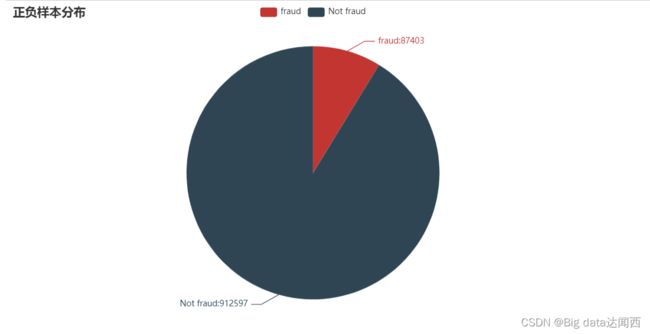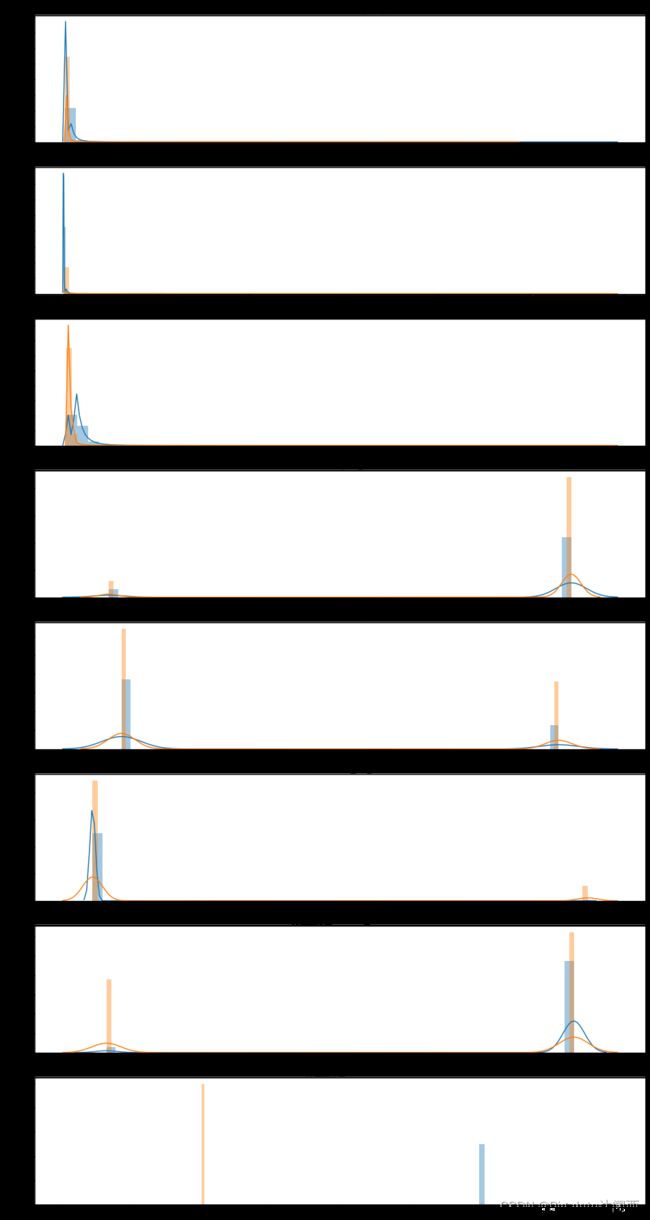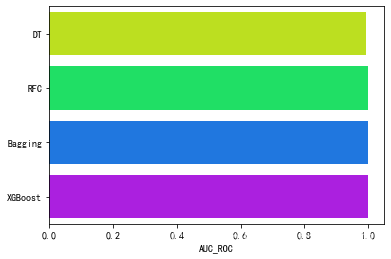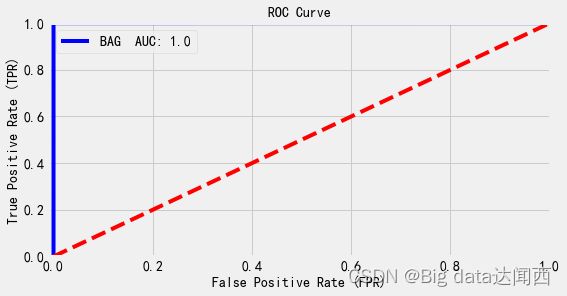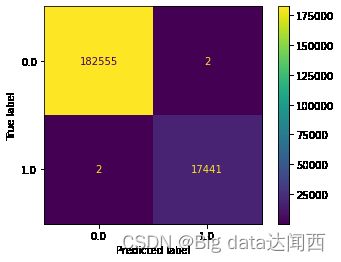钉钉杯初赛A题建模-多模型融合预测银行卡诈骗模型(详细代码、解释)
钉钉杯初赛A题建模-多模型融合预测银行卡诈骗模型
前言:
8月10结束的钉钉杯a题,整体简单,建模整体代码分享如下,主要是进行了多个模型投票法融合的模型。
数据+全部代码:
链接:https://pan.baidu.com/s/1SZtLsuPHSmlaOy111uW_YA
提取码:xx78
1、对数据进行前两列特征数据进行标准化
2、采用上采样和下采样进行数据处理,使数据极不平衡得到处理
3、使用上采样和下采样的数据分别用第一阶段的5个模型进行训练和预测
4、模型优化,使用roc_auc曲线选出最好的三个模型进行保存,在第三阶段进行模型融合
5、加载四个模型融合为一个模型
6、对融合后的模型进行训练和模型评估
7、混淆矩阵查看模型的效果
数据读取与查看
读取数据
import pandas as pd
import numpy as np
df=pd.read_csv("数据集/card_transdata.csv",encoding='utf-8') #文件路径为绝对路径,根据自己电脑文件夹的路径修改
df
| distance_from_home | distance_from_last_transaction | ratio_to_median_purchase_price | repeat_retailer | used_chip | used_pin_number | online_order | fraud | |
|---|---|---|---|---|---|---|---|---|
| 0 | 57.877857 | 0.311140 | 1.945940 | 1.0 | 1.0 | 0.0 | 0.0 | 0.0 |
| 1 | 10.829943 | 0.175592 | 1.294219 | 1.0 | 0.0 | 0.0 | 0.0 | 0.0 |
| 2 | 5.091079 | 0.805153 | 0.427715 | 1.0 | 0.0 | 0.0 | 1.0 | 0.0 |
| 3 | 2.247564 | 5.600044 | 0.362663 | 1.0 | 1.0 | 0.0 | 1.0 | 0.0 |
| 4 | 44.190936 | 0.566486 | 2.222767 | 1.0 | 1.0 | 0.0 | 1.0 | 0.0 |
| ... | ... | ... | ... | ... | ... | ... | ... | ... |
| 999995 | 2.207101 | 0.112651 | 1.626798 | 1.0 | 1.0 | 0.0 | 0.0 | 0.0 |
| 999996 | 19.872726 | 2.683904 | 2.778303 | 1.0 | 1.0 | 0.0 | 0.0 | 0.0 |
| 999997 | 2.914857 | 1.472687 | 0.218075 | 1.0 | 1.0 | 0.0 | 1.0 | 0.0 |
| 999998 | 4.258729 | 0.242023 | 0.475822 | 1.0 | 0.0 | 0.0 | 1.0 | 0.0 |
| 999999 | 58.108125 | 0.318110 | 0.386920 | 1.0 | 1.0 | 0.0 | 1.0 | 0.0 |
1000000 rows × 8 columns
查看数据情况
df.info()
RangeIndex: 1000000 entries, 0 to 999999
Data columns (total 8 columns):
# Column Non-Null Count Dtype
--- ------ -------------- -----
0 distance_from_home 1000000 non-null float64
1 distance_from_last_transaction 1000000 non-null float64
2 ratio_to_median_purchase_price 1000000 non-null float64
3 repeat_retailer 1000000 non-null float64
4 used_chip 1000000 non-null float64
5 used_pin_number 1000000 non-null float64
6 online_order 1000000 non-null float64
7 fraud 1000000 non-null float64
dtypes: float64(8)
memory usage: 61.0 MB
- 数据的类型基本是float64。即都是数字形式
- 数据中没有空行
# 介绍数据集各列的 数据统计情况
df.describe()
| distance_from_home | distance_from_last_transaction | ratio_to_median_purchase_price | repeat_retailer | used_chip | used_pin_number | online_order | fraud | |
|---|---|---|---|---|---|---|---|---|
| count | 1000000.000000 | 1000000.000000 | 1000000.000000 | 1000000.000000 | 1000000.000000 | 1000000.000000 | 1000000.000000 | 1000000.000000 |
| mean | 26.628792 | 5.036519 | 1.824182 | 0.881536 | 0.350399 | 0.100608 | 0.650552 | 0.087403 |
| std | 65.390784 | 25.843093 | 2.799589 | 0.323157 | 0.477095 | 0.300809 | 0.476796 | 0.282425 |
| min | 0.004874 | 0.000118 | 0.004399 | 0.000000 | 0.000000 | 0.000000 | 0.000000 | 0.000000 |
| 25% | 3.878008 | 0.296671 | 0.475673 | 1.000000 | 0.000000 | 0.000000 | 0.000000 | 0.000000 |
| 50% | 9.967760 | 0.998650 | 0.997717 | 1.000000 | 0.000000 | 0.000000 | 1.000000 | 0.000000 |
| 75% | 25.743985 | 3.355748 | 2.096370 | 1.000000 | 1.000000 | 0.000000 | 1.000000 | 0.000000 |
| max | 10632.723672 | 11851.104565 | 267.802942 | 1.000000 | 1.000000 | 1.000000 | 1.000000 | 1.000000 |
- 可以观察到distance_from_home(银行卡交易地点与家的距离)和distance_from_last_transaction(与上次交易发生的距离)的方差相对于其他特征很大
数据分析可视化
print('distance_from_home不是诈骗统计:'+str(len(df.loc[(df['fraud'] == 0),'distance_from_home'])))
print('distance_from_home是诈骗统计:'+str(len(df.loc[(df['fraud'] == 1),'distance_from_home'])))
print('distance_from_last_transaction不是诈骗统计:'+str(len(df.loc[(df['fraud'] == 0),'distance_from_last_transaction'])))
print('distance_from_last_transaction是诈骗统计:'+str(len(df.loc[(df['fraud'] == 1),'distance_from_last_transaction'])))
print('ratio_to_median_purchase_price不是诈骗统计:'+str(len(df.loc[(df['fraud'] == 0),'ratio_to_median_purchase_price'])))
print('ratio_to_median_purchase_price是诈骗统计:'+str(len(df.loc[(df['fraud'] == 1),'ratio_to_median_purchase_price'])))
distance_from_home不是诈骗统计:912597
distance_from_home是诈骗统计:87403
distance_from_last_transaction不是诈骗统计:912597
distance_from_last_transaction是诈骗统计:87403
ratio_to_median_purchase_price不是诈骗统计:912597
ratio_to_median_purchase_price是诈骗统计:87403
查看正负样本数量:
from pyecharts.charts import Pie
from pyecharts import options as opts
L1=['fraud','Not fraud']
num=[87403,912597]
c=Pie()
c.add("",[list(z) for z in zip(L1,num)])
c.set_global_opts(title_opts=opts.TitleOpts(title="正负样本分布"))
c.set_series_opts(label_opts=opts.LabelOpts(formatter="{b}:{c}"))
c.render_notebook()
-
从中我们可以观察到,正样本数量远远大于负样本数量,正负样本数量不均衡。
-
大部分分类器的输出类别是基于阈值的,如小于0.5的为反例,大于则为正例。在数据不平衡时,默认的阈值会导致模型输出倾向与类别数据多的类别
-
这里我们采用下采样的方法平衡数据
下采样 :从大量的正样本中挑选若干个,使得正样本和负样本数目一样小
观察distance_from_home和是否诈骗的关系
#### 观察distance和是否诈骗的关系
import matplotlib.pyplot as plt
# 构建两个子图
f, (ax1, ax2) = plt.subplots(2, 1, sharex=True, figsize=(16,4))
# 设置柱状宽度
bins = 30
# 统计欺诈案例的交易金额
ax1.hist(df["distance_from_home"][df["fraud"]== 1], bins = bins)
ax1.set_title('Fraud')
# 统计正常案例的交易金额
ax2.hist(df["distance_from_home"][df["fraud"] == 0], bins = bins)
ax2.set_title('Not Fraud')
# 画坐标系
plt.xlabel('distance')
plt.ylabel('Number of Transactions')
plt.yscale('log')
plt.show() # 展示图像
- k可以看出咋骗集中在distance大约为500以内,说明可能是同城诈骗居多。
观察distance_from_last_transaction:和是否诈骗的关系
#### 观察distance和是否诈骗的关系
import matplotlib.pyplot as plt
# 构建两个子图
f, (ax1, ax2) = plt.subplots(2, 1, sharex=True, figsize=(16,4))
# 设置柱状宽度
bins = 30
# 统计欺诈案例的交易金额
ax1.hist(df["distance_from_last_transaction"][df["fraud"]== 1], bins = bins)
ax1.set_title('Fraud')
# 统计正常案例的交易金额
ax2.hist(df["distance_from_last_transaction"][df["fraud"] == 0], bins = bins)
ax2.set_title('Not Fraud')
# 画坐标系
plt.xlabel('distance')
plt.ylabel('Number of Transactions')
plt.yscale('log')
plt.show() # 展示图像
同城诈骗,可能距离小不容易引起怀疑
观察各个特征之间的联系
import seaborn as sns
# 创建图像
grid_kws = {"width_ratios": (.9, .9, .05), "wspace": 0.2}
f, (ax1, ax2, cbar_ax) = plt.subplots(1, 3, gridspec_kw=grid_kws, figsize = (18, 9))
# 定义调色板
cmap = sns.diverging_palette(220, 8, as_cmap=True)
# 计算正常案例中的特征联系
correlation_NonFraud = df[df["fraud"] == 0].loc[:, df.columns != 'fraud'].corr()
# 计算欺诈案例中的特征联系
correlation_Fraud = df[df["fraud"] == 1].loc[:, df.columns != 'fraud'].corr()
# 计算上三角mask矩阵
mask = np.zeros_like(correlation_NonFraud)
indices = np.triu_indices_from(correlation_NonFraud)
mask[indices] = True
# 画正常案例的特征联系热力图
ax1 =sns.heatmap(correlation_NonFraud, ax = ax1, vmin = -1, vmax = 1, cmap = cmap, square = False, \
linewidths = 0.5, mask = mask, cbar = False)
ax1.set_xticklabels(ax1.get_xticklabels(), size = 16);
ax1.set_yticklabels(ax1.get_yticklabels(), size = 16);
ax1.set_title('Normal', size = 20)
# 画欺诈案例的特征联系热力图
ax2 = sns.heatmap(correlation_Fraud, vmin = -1, vmax = 1, cmap = cmap, ax = ax2, square = False, \
linewidths = 0.5, mask = mask, yticklabels = False, \
cbar_ax = cbar_ax, cbar_kws={'orientation': 'vertical', 'ticks': [-1, -0.5, 0, 0.5, 1]})
ax2.set_xticklabels(ax2.get_xticklabels(), size = 16);
ax2.set_title('Fraud', size = 20);
cbar_ax.set_yticklabels(cbar_ax.get_yticklabels(), size = 14);
plt.show() # 展示图像
df.corr()
| distance_from_home | distance_from_last_transaction | ratio_to_median_purchase_price | repeat_retailer | used_chip | used_pin_number | online_order | fraud | |
|---|---|---|---|---|---|---|---|---|
| distance_from_home | 1.000000 | 0.000193 | -0.001374 | 0.143124 | -0.000697 | -0.001622 | -0.001301 | 0.187571 |
| distance_from_last_transaction | 0.000193 | 1.000000 | 0.001013 | -0.000928 | 0.002055 | -0.000899 | 0.000141 | 0.091917 |
| ratio_to_median_purchase_price | -0.001374 | 0.001013 | 1.000000 | 0.001374 | 0.000587 | 0.000942 | -0.000330 | 0.462305 |
| repeat_retailer | 0.143124 | -0.000928 | 0.001374 | 1.000000 | -0.001345 | -0.000417 | -0.000532 | -0.001357 |
| used_chip | -0.000697 | 0.002055 | 0.000587 | -0.001345 | 1.000000 | -0.001393 | -0.000219 | -0.060975 |
| used_pin_number | -0.001622 | -0.000899 | 0.000942 | -0.000417 | -0.001393 | 1.000000 | -0.000291 | -0.100293 |
| online_order | -0.001301 | 0.000141 | -0.000330 | -0.000532 | -0.000219 | -0.000291 | 1.000000 | 0.191973 |
| fraud | 0.187571 | 0.091917 | 0.462305 | -0.001357 | -0.060975 | -0.100293 | 0.191973 | 1.000000 |
从上图可以看出
- 在银行卡诈骗事件中,变量distance_from_home、ratio_to_median_purchase_price、repeat_retailer与属于诈骗有较强的
观察各个特征分布
import matplotlib.pyplot as plt
import matplotlib.gridspec as gridspec
import seaborn as sns
# 特征名
feature_num = len(df.columns)
v_feat = list(df.columns)
# 构建图像
plt.figure(figsize=(16,feature_num*4))
gs = gridspec.GridSpec(feature_num, 1)
for i, cn in enumerate(df[v_feat]):
ax = plt.subplot(gs[i])
sns.distplot(df[cn][df["fraud"] == 1], bins=50)
sns.distplot(df[cn][df["fraud"] == 0], bins=100)
ax.set_xlabel('')
ax.set_title('特征直方图: ' + str(cn))
plt.rcParams['font.sans-serif']=['SimHei']
plt.show() # 展示图像
特征工程
数据标准化
# 统一导入工具包
import numpy as np
import pandas as pd
import os
from sklearn.preprocessing import StandardScaler
from sklearn.compose import ColumnTransformer
from sklearn.model_selection import train_test_split, GridSearchCV
from sklearn.ensemble import RandomForestClassifier
from sklearn.metrics import roc_auc_score, classification_report, roc_curve, auc, plot_confusion_matrix, precision_score, recall_score, f1_score
from imblearn.over_sampling import SMOTE
from imblearn.under_sampling import RandomUnderSampler
from imblearn.pipeline import Pipeline
from joblib import dump, load
import matplotlib.pyplot as plt
import matplotlib.gridspec as gridspec
import seaborn as sns
# 观察特征返回每列的标准偏差
df.var()
distance_from_home 4275.954684
distance_from_last_transaction 667.865469
ratio_to_median_purchase_price 7.837698
repeat_retailer 0.104430
used_chip 0.227620
used_pin_number 0.090486
online_order 0.227334
fraud 0.079764
dtype: float64
- 前两个方差太大,我们需要对其进行标准化 因为模型会对方差较大的特征值误认为它对与分类有着较大的权重,因此把数据大小劲量均衡
### 单独使用StandardScaler()进行标准化
from sklearn.preprocessing import StandardScaler
old_dfh = df['distance_from_home'].values.reshape(-1, 1)
# print(old_amount)
print('distance_from_home标准化之前的方差', old_dfh.std())
norm_dfh = StandardScaler().fit_transform(df['distance_from_home'].values.reshape(-1, 1))
print('distance_from_home标准化之后的方差', norm_dfh.std())
### 单独使用StandardScaler()进行标准化
from sklearn.preprocessing import StandardScaler
old_dflt = df['distance_from_last_transaction'].values.reshape(-1, 1)
# print(old_amount)
print('distance_from_last_transaction标准化之前的方差', old_dflt.std())
norm_dflt = StandardScaler().fit_transform(df['distance_from_last_transaction'].values.reshape(-1, 1))
print('distance_from_last_transaction标准化之后的方差', norm_dflt.std())
distance_from_home标准化之前的方差 65.39075170364431
distance_from_home标准化之后的方差 1.0000000000000004
distance_from_last_transaction标准化之前的方差 25.843080339696936
distance_from_last_transaction标准化之后的方差 1.0
# 封装到ColumnTransformer中,方便后续调用标准化操作
column_trans = Pipeline([('scaler', StandardScaler())])
preprocessing = ColumnTransformer(
transformers=[
('column_trans', column_trans, ['distance_from_home','distance_from_last_transaction'])
], remainder='passthrough'
)
过采样与欠采样数据处理
-
SMOTE算法过采样的思想是合成新的少数类样本,合成的策略是对每个少数类样本a,从它的最近邻中随机选一个样本b,然后在a、b之间的连线上随机选一点作为新合成的少数类样本。
-
如果采用欠采样的方法,通常是对数目较多的那一类样本进行随机挑选样本,使得两类样本数目相等。这种做法会抛弃了大部分数据。
划分数据集
x = df.drop('fraud',axis=1)
x
y = df['fraud']
y
X_train, X_test, y_train, y_test = train_test_split(x, y, test_size=0.2, random_state=42)
#查看维度
print('x_train.shape:',X_train.shape)
print('y_train.shape:',y_train.shape)
print('x_test.shape:',X_test.shape)
print('y_test.shape:',y_test.shape)
x_train.shape: (800000, 7)
y_train.shape: (800000,)
x_test.shape: (200000, 7)
y_test.shape: (200000,)
SMOTE过采样
### 单独使用SMOTE的结果
# 利用SMOTE进行过采样
print('过采样前,1的样本的个数为:',len(y_train[y_train==1]))
print('过采样前,0的样本的个数为:',len(y_train[y_train==0]))
over_sampler=SMOTE(random_state=0)
X_os_train,y_os_train=over_sampler.fit_resample(X_train,y_train)
print('过采样后,1的样本的个数为:',len(y_os_train[y_os_train==1]))
print('过采样后,0的样本的个数为:',len(y_os_train[y_os_train==0]))
过采样前,1的样本的个数为: 69960
过采样前,0的样本的个数为: 730040
过采样后,1的样本的个数为: 730040
过采样后,0的样本的个数为: 730040
随机欠采样
### 单独使用随机欠采样的结果
print('欠采样前,1的样本的个数为:',len(y_train[y_train==1]))
print('欠采样前,0的样本的个数为:',len(y_train[y_train==0]))
under_sampler=RandomUnderSampler(random_state=0)
X_us_train,y_us_train=under_sampler.fit_resample(X_train,y_train)
print('欠采样后,1的样本的个数为:',len(y_us_train[y_us_train==1]))
print('欠采样后,0的样本的个数为:',len(y_us_train[y_us_train==0]))
欠采样前,1的样本的个数为: 69960
欠采样前,0的样本的个数为: 730040
欠采样后,1的样本的个数为: 69960
欠采样后,0的样本的个数为: 69960
流水线建构模型
数据在进行模型拟合之前,需要先将数据进行输入标准化等操作转换为新数据,对于新数据,模型的预测和评估都需要进行多次转换。使用Pipeline(流水线)技术可以将数据处理和模型拟合结合在一起,减少代码量。
Pipeline 的中间过程由sklearn相适配的转换器(transformer)构成,最后一步是一个estimator(模型)。中间的节点都可以执行fit和transform方法,这样预处理都可以封装进去;最后节点只需要实现fit方法
from sklearn.linear_model import SGDClassifier # 随机梯度
from sklearn.neighbors import KNeighborsClassifier # K近邻
from sklearn.tree import DecisionTreeClassifier # 决策树
from sklearn.ensemble import RandomForestClassifier # 随机森林
from sklearn.model_selection import cross_val_score # 交叉验证计算accuracy
from sklearn.model_selection import GridSearchCV # 网格搜索,获取最优参数
from sklearn.model_selection import StratifiedKFold # 交叉验证
from collections import Counter
from xgboost import XGBClassifier
# 评估指标
from sklearn.metrics import confusion_matrix, precision_score, recall_score, f1_score, roc_auc_score, accuracy_score, classification_report
from sklearn.ensemble import BaggingClassifier # 集成学习
过采样流水线模型训练分数
classifiers = {
"KNN":KNeighborsClassifier(), # K近邻
'DT':DecisionTreeClassifier(), # 决策树
'RFC':RandomForestClassifier(), # 随机森林
'Bagging':BaggingClassifier(), # 集成学习bagging
'SGD':SGDClassifier(), #随机梯度
'XGB':XGBClassifier() #XGBoost算法
}
def accuracy_scores(x_train, y_train):
for key, classifier in classifiers.items(): # 遍历每一个分类器,分别训练、计算得分
over_pipe = Pipeline([
('preprocessing', preprocessing),
('sampler', SMOTE() ), # 数据高度不平衡,因此使用SMOTE对少数类进行过采样
('classifier',classifier)
])
over_pipe.fit(x_train, y_train)
training_score = cross_val_score(over_pipe, x_train, y_train, cv=5) # 5折交叉验证
print("Classifier Name : ", classifier.__class__.__name__," Training Score :", round(training_score.mean(), 4)*100,'%')
print("过采样的各个分类模型的训练分数:")
accuracy_scores(X_train,y_train)
过采样的各个分类模型的训练分数:
Classifier Name : KNeighborsClassifier Training Score : 99.8 %
Classifier Name : DecisionTreeClassifier Training Score : 100.0 %
Classifier Name : RandomForestClassifier Training Score : 100.0 %
Classifier Name : BaggingClassifier Training Score : 100.0 %
Classifier Name : SGDClassifier Training Score : 92.77 %
Classifier Name : XGBClassifier Training Score : 100.0 %
欠采样流水线模型训练分数
def under_accuracy_scores(x_train, y_train):
for key, classifier in classifiers.items(): # 遍历每一个分类器,分别训练、计算得分
# 欠采样
under_pipe = Pipeline([
('preprocessing', preprocessing),
('sampler', RandomUnderSampler() ), # The data is highly imbalanced, hence undersample majority class with RandomUnderSampler
('classifier', classifier)
])
under_pipe.fit(x_train, y_train)
training_score = cross_val_score(under_pipe, x_train, y_train, cv=5) # 5折交叉验证
print("Classifier Name : ", classifier.__class__.__name__," Training Score :", round(training_score.mean(), 4)*100,'%')
print("欠采样的各个分类模型的训练分数:")
under_accuracy_scores(X_train,y_train)
欠采样的各个分类模型的训练分数:
Classifier Name : KNeighborsClassifier Training Score : 99.26 %
Classifier Name : DecisionTreeClassifier Training Score : 99.99 %
Classifier Name : RandomForestClassifier Training Score : 99.99 %
Classifier Name : BaggingClassifier Training Score : 99.99 %
Classifier Name : SGDClassifier Training Score : 92.46 %
Classifier Name : XGBClassifier Training Score : 99.99 %
综上过采样和欠采样的模型训练分数:
-
过采样的模型比欠采样的模型训练分数高
-
在过采样模型中 ,决策树模型、随机森林模型、Bagging模型、XGBoost模型的训练分数达到了100%,我们选择这四个模型作为分类模型,
-
后面对这四个模型进行最优参数搜索、融合模型
网格搜索,得到每个模型的最优参数模型
- cross_val_score :
一般用于获取每折的交叉验证的得分,然后根据这个得分为模型选择合适的超参数,通常需要编写循环手动完成交叉验证过程;
- GridSearchCV :
除了自行完成叉验证外,还返回了最优的超参数及对应的最优模型
所以相对于cross_val_score来说,GridSearchCV在使用上更为方便;但是对于细节理解上,手动实现循环调用cross_val_score会更好些。
#1、决策树模型最优参数寻找
def DT_gs(x_train, y_train):
DT_param = {
'classifier__criterion':['gini', 'entropy'], # 衡量标准
'classifier__max_depth':list(range(2, 5, 1)), # 树的深度
'classifier__min_samples_leaf':list(range(2, 7, 1)) # 最小叶子节点数
}
DT_pipe =Pipeline([
('preprocessing', preprocessing),
('sampler', SMOTE() ), # 数据高度不平衡,因此使用SMOTE对少数类进行过采样
('classifier',DecisionTreeClassifier())
])
dt_gs = GridSearchCV(estimator=DT_pipe,param_grid=DT_param, n_jobs=-1,verbose=50, cv=4, scoring='roc_auc')
dt_gs.fit(x_train, y_train)
dt_best_estimators = dt_gs.best_estimator_ # 最优参数
return dt_best_estimators
# 2、随机森林最优参数选择
def RFC_gs(x_train, y_train):
grid_search_models = {
'classifier__n_estimators': [25,50,75,100,200] # 仅作示例,可以选择其他参数
}
RFC_over_pipe = Pipeline([
('preprocessing', preprocessing),
('sampler', SMOTE() ), # 数据高度不平衡,因此使用SMOTE对少数类进行过采样
('classifier',RandomForestClassifier())
])
pipe = GridSearchCV(RFC_over_pipe, grid_search_models, verbose=50, cv=5, scoring='roc_auc')
pipe.fit(x_train, y_train)
bst = pipe.best_estimator_ # 最优参数
return bst
# 3、Bagging模型最优参数选择
def bag_gs(x_train, y_train):
BAG_param = {
'classifier__n_estimators':[10, 15, 20] #集成的基估计器的个数
}
bag_over_pipe = Pipeline([
('preprocessing', preprocessing),
('sampler', SMOTE() ), # 数据高度不平衡,因此使用SMOTE对少数类进行过采样
('classifier',BaggingClassifier())
])
bag_over_pipe = GridSearchCV(bag_over_pipe, BAG_param, verbose=50, cv=5, scoring='roc_auc')
bag_over_pipe.fit(x_train, y_train)
bag_bst = bag_over_pipe.best_estimator_ # 最优参数
return bag_bst
# 3、XGBoost模型最优参数选择
def xgb_gs(x_train, y_train):
XGB_param = {
'classifier__max_depth':[3,4,5,6]
}
xgb_over_pipe = Pipeline([
('preprocessing', preprocessing),
('sampler', SMOTE() ), # 数据高度不平衡,因此使用SMOTE对少数类进行过采样
('classifier',XGBClassifier())
])
xgb_over_pipe = GridSearchCV(xgb_over_pipe, XGB_param, verbose=50, cv=5, scoring='roc_auc')
xgb_over_pipe.fit(x_train, y_train)
xgb_bst = xgb_over_pipe.best_estimator_ # 最优参数
return xgb_bst
# 得到最优参数模型
DT_best_estimator = DT_gs(X_train, y_train)
RFC_best_estimator = RFC_gs(X_train, y_train)
BAG_best_estimator = bag_gs(X_train, y_train)
XGB_best_estimator = xgb_gs(X_train,y_train)
print('4个模型最优参数:')
print('DT_best_estimator:',DT_best_estimator)
print('RFC_best_estimator:',RFC_best_estimator)
print('BAG_best_estimator:',BAG_best_estimator)
print('XGB_best_estimator:',XGB_best_estimator)
4个模型最优参数:
DT_best_estimator: Pipeline(steps=[('preprocessing',
ColumnTransformer(remainder='passthrough',
transformers=[('column_trans',
Pipeline(steps=[('scaler',
StandardScaler())]),
['distance_from_home',
'distance_from_last_transaction'])])),
('sampler', SMOTE()),
('classifier',
DecisionTreeClassifier(max_depth=4, min_samples_leaf=4))])
RFC_best_estimator: Pipeline(steps=[('preprocessing',
ColumnTransformer(remainder='passthrough',
transformers=[('column_trans',
Pipeline(steps=[('scaler',
StandardScaler())]),
['distance_from_home',
'distance_from_last_transaction'])])),
('sampler', SMOTE()),
('classifier', RandomForestClassifier(n_estimators=75))])
BAG_best_estimator: Pipeline(steps=[('preprocessing',
ColumnTransformer(remainder='passthrough',
transformers=[('column_trans',
Pipeline(steps=[('scaler',
StandardScaler())]),
['distance_from_home',
'distance_from_last_transaction'])])),
('sampler', SMOTE()), ('classifier', BaggingClassifier())])
XGB_best_estimator: Pipeline(steps=[('preprocessing',
ColumnTransformer(remainder='passthrough',
transformers=[('column_trans',
Pipeline(steps=[('scaler',
StandardScaler())]),
['distance_from_home',
'distance_from_last_transaction'])])),
('sampler', SMOTE()),
('classifier',
XGBClassifier(base_score=0.5, booster='gbtree', callbacks=None,
colsample_bylevel=1, colsample_bynode=1,
colsa...
gamma=0, gpu_id=-1, grow_policy='depthwise',
importance_type=None, interaction_constraints='',
learning_rate=0.300000012, max_bin=256,
max_cat_to_onehot=4, max_delta_step=0,
max_depth=3, max_leaves=0, min_child_weight=1,
missing=nan, monotone_constraints='()',
n_estimators=100, n_jobs=0, num_parallel_tree=1,
predictor='auto', random_state=0, reg_alpha=0,
reg_lambda=1, ...))])
保存最优参数的四个模型
import joblib as jl
#保存决策树模型:
jl.dump(DT_best_estimator,'./模型保存/dt.pkl')
#保存随机森林模型:
jl.dump(RFC_best_estimator,'./模型保存/rfc.pkl')
#保存bagging模型:
jl.dump(BAG_best_estimator,'./模型保存/bag.pkl')
#保存xgboost模型:
jl.dump(XGB_best_estimator,'./模型保存/xgb.pkl')
四个模型模型评估
评估指标数据
用 precision_recall_fscore_support 可以同时计算真实值和预测值之间的精确率、召回率、F 值、支持度。支持度为在真实值每一类出现的事件次数。
from sklearn.metrics import precision_recall_fscore_support
from sklearn.metrics import accuracy_score
def caculate(models, x_test, y_test):
# 计算各种参数的值
accuracy_results = []
F1_score_results = []
Recall_results = []
Precision_results = []
AUC_ROC_results = []
for model in models:
y_pred = model.predict(x_test)
accuracy = accuracy_score(y_test, y_pred) # 计算准确度
precision, recall, f1_score, _ = precision_recall_fscore_support(y_test, y_pred) # 计算:精确度,召回率,f1_score
AUC_ROC = roc_auc_score(y_test, y_pred) # 计算AUC
# 保存计算值
accuracy_results.append(round(accuracy,4))
F1_score_results.append(round(f1_score.mean(),4))
Recall_results.append(round(recall.mean(),4))
AUC_ROC_results.append(AUC_ROC)
Precision_results.append(round(precision.mean(),4))
return accuracy_results, F1_score_results, Recall_results, AUC_ROC_results, Precision_results
# 将所有最优超参数的模型放在一起
best_models = [ DT_best_estimator, RFC_best_estimator, BAG_best_estimator, XGB_best_estimator]
# 调用函数计算各项指标值
accuracy_results, F1_score_results, Recall_results, AUC_ROC_results, Precision_results = caculate(best_models, X_test, y_test)
# 将各项值放入到DataFrame中
result_df = pd.DataFrame(columns=['Accuracy', 'F1-score', 'Recall', 'Precision', 'AUC_ROC'],
index=['DT','RFC','Bagging','XGBoost'])
result_df['Accuracy'] = accuracy_results
result_df['F1-score'] = F1_score_results
result_df['Recall'] = Recall_results
result_df['Precision'] = Precision_results
result_df['AUC_ROC'] = AUC_ROC_results
result_df
| Accuracy | F1-score | Recall | Precision | AUC_ROC | |
|---|---|---|---|---|---|
| DT | 0.9934 | 0.9799 | 0.9927 | 0.9680 | 0.992728 |
| RFC | 1.0000 | 1.0000 | 0.9999 | 1.0000 | 0.999940 |
| Bagging | 1.0000 | 0.9999 | 0.9999 | 0.9999 | 0.999929 |
| XGBoost | 1.0000 | 0.9999 | 1.0000 | 0.9999 | 0.999986 |
可视化 AUC_ROC的评分.
# 可视化 AUC的评分.
g = sns.barplot('AUC_ROC', result_df.index, data=result_df, palette='hsv', orient='h')
计算各个模型的AUC值
from sklearn.model_selection import cross_val_predict
DT_pred = DT_best_estimator.predict(X_test)
RFC_pred = RFC_best_estimator.predict(X_test)
BAG_pred = BAG_best_estimator.predict(X_test)
XGB_pred = XGB_best_estimator.predict(X_test)
print(DT_pred)
print(RFC_pred)
print(BAG_pred)
print(XGB_pred)
[0. 0. 0. ... 1. 0. 0.]
[0. 0. 0. ... 1. 0. 0.]
[0. 0. 0. ... 1. 0. 0.]
[0 0 0 ... 1 0 0]
# 计算auc的评分
print('决策树模型auc分数 :', round(roc_auc_score(y_test, DT_pred),2))
print('随机森林模型auc分数 :', round(roc_auc_score(y_test, RFC_pred),2))
print('bagging模型auc分数 :', round(roc_auc_score(y_test, BAG_pred),2))
print('xgboost模型auc分数 :', round(roc_auc_score(y_test, XGB_pred),2))
决策树模型auc分数 : 0.99
随机森林模型auc分数 : 1.0
bagging模型auc分数 : 1.0
xgboost模型auc分数 : 1.0
绘制各个模型的roc曲线:
DT_fpr, DT_tpr, DT_threshold = roc_curve(y_test, DT_pred)
RFC_fpr, RFC_tpr, RFC_threshold = roc_curve(y_test, RFC_pred)
BAG_fpr, BAG_tpr, BAG_threshold = roc_curve(y_test, BAG_pred)
XGB_fpr, XGB_tpr, XGB_threshold = roc_curve(y_test, XGB_pred)
# 绘制roc曲线
def graph_roc(fpr, tpr, name, score):
plt.figure(figsize=(8,4)) # 画布大小
plt.title("ROC Curve", fontsize=14)
plt.plot(fpr, tpr, 'b',label=name+" AUC: "+ str(round(score,2)))
plt.plot([0, 1], [0, 1], color='r', linestyle='--')
plt.axis([-0.01, 1, 0, 1]) # 坐标轴
plt.xlabel("False Positive Rate (FPR)", fontsize=14)
plt.ylabel("True Positive Rate (TPR)", fontsize=14)
plt.legend()
plt.show()
#决策树
graph_roc(DT_fpr, DT_tpr, 'DT', roc_auc_score(y_test, DT_pred))
# 随机森林
graph_roc(RFC_fpr, RFC_tpr, 'RFC', roc_auc_score(y_test, RFC_pred))
#bag
graph_roc(BAG_fpr,BAG_tpr, 'BAG', roc_auc_score(y_test, BAG_pred))
#XGB
graph_roc(XGB_fpr,XGB_tpr, 'XGB', roc_auc_score(y_test, XGB_pred))
模型评估总结
,四个效果好的模型在模型评估上展现
准确率、精确率、召回率、F1值、ROC曲线、AUC 都显示很高, 说明四个模型在分类上效果显著,可信度高
加载模型、融合
import joblib
model1 = joblib.load(filename="./模型保存/dt.pkl")
model1
model2 = joblib.load('./模型保存/rfc.pkl')
model3 = joblib.load('./模型保存/bag.pkl')
model4 = joblib.load('./模型保存/xgb.pkl')
# 将4个较好的模型集成起来,当做一个模型
from sklearn.ensemble import VotingClassifier
voting_clf = VotingClassifier(estimators=[('DT', model1), ('RFC', model2), ('BAG',model3),
('XGB', model4)], n_jobs=-1,voting='soft')
voting_clf
模型训练
import pandas as pd
import numpy as np
df=pd.read_csv("数据集/card_transdata.csv",encoding='utf-8') #文件路径为绝对路径,根据自己电脑文件夹的路径修改
df
x = df.drop('fraud',axis=1)
x
y = df['fraud']
y
from sklearn.model_selection import train_test_split, GridSearchCV
X_train, X_test, y_train, y_test = train_test_split(x, y, test_size=0.2, random_state=42)
#查看维度
print('x_train.shape:',X_train.shape)
print('y_train.shape:',y_train.shape)
print('x_test.shape:',X_test.shape)
print('y_test.shape:',y_test.shape)
x_train.shape: (800000, 7)
y_train.shape: (800000,)
x_test.shape: (200000, 7)
y_test.shape: (200000,)
# 训练
voting_clf.fit(X_train, y_train)
#训练分数
from sklearn.model_selection import cross_val_score # 交叉验证计算accuracy
training_score = cross_val_score(voting_clf, X_train, y_train, cv=5) # 5折交叉验证
print("融合后模型训练分数:", round(training_score.mean(), 4)*100,'%')
融合后模型训练分数: 100.0 %
# 预测
y_final_pred = voting_clf.predict(X_test)
y_final_pred
array([0., 0., 0., ..., 1., 0., 0.])
模型评估
from sklearn.metrics import roc_auc_score, classification_report, roc_curve, auc, plot_confusion_matrix, precision_score, recall_score, f1_score
混淆矩阵
#
import matplotlib.pyplot as plt
plot_confusion_matrix(voting_clf, X_test, y_test)
plt.show() # 展示图像
计算精确率、召回率以及综合两者的F1值
y_preds = voting_clf.predict(X_test)
p = precision_score(y_test, y_preds)
r = recall_score(y_test, y_preds)
f1 = f1_score(y_test, y_preds)
print("precision(准确率): ", p)
print("recall(召回率): ", r)
print("F1: ", f1)
precision(准确率): 0.9998853408243995
recall(召回率): 0.9998853408243995
F1: 0.9998853408243995
print(classification_report(y_test, y_preds)) #评价指标
precision recall f1-score support
0.0 1.00 1.00 1.00 182557
1.0 1.00 1.00 1.00 17443
accuracy 1.00 200000
macro avg 1.00 1.00 1.00 200000
weighted avg 1.00 1.00 1.00 200000
保存融合后的模型
joblib.dump(voting_clf,'./模型保存/best_model.pkl')

